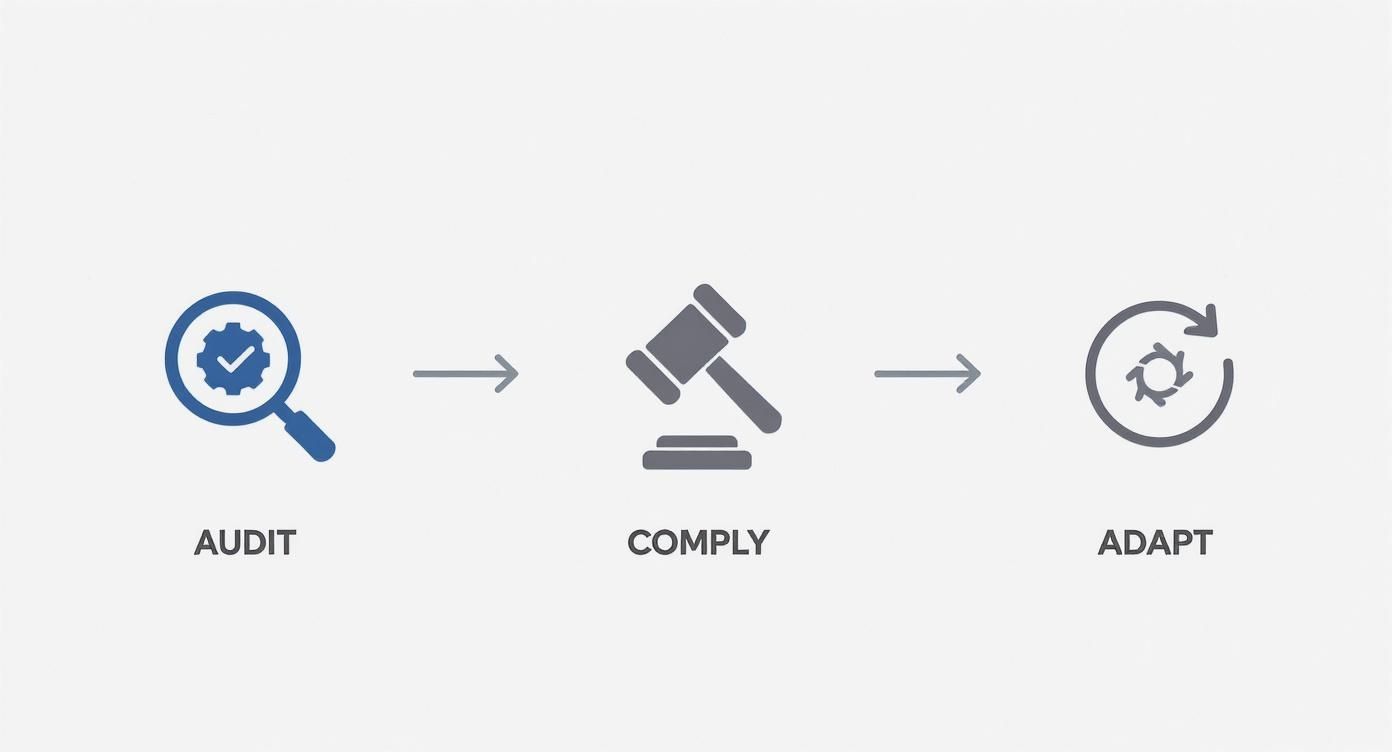Responsible AI Implementation Made Practical
Responsible AI isn’t just a technical challenge; it’s about embedding ethical, transparent, and accountable practices into every AI system you build and deploy. This process starts long before a single line of code gets written. It begins with a rock-solid governance framework that’s woven into your company’s values and business goals.
Building Your Responsible AI Governance Framework
Getting responsible AI right means moving from abstract principles to concrete actions. When you build these considerations into your strategy from the very beginning, responsible AI stops being a compliance headache and becomes a genuine competitive advantage.

This foundational phase isn’t about algorithms or data pipelines. It’s about getting the human infrastructure right—the people, principles, and processes that will guide your technology.
Assembling the AI Ethics Committee
Your first practical step is to form an AI ethics committee or council. This can’t live in a single department. To truly see the whole picture and spot the inevitable blind spots, you need a cross-functional team with diverse viewpoints who aren’t afraid to challenge assumptions.
Your committee should be a mix of expertise from across the business:
- Legal and Compliance: These are your experts for navigating the ever-changing regulatory maze and keeping you on the right side of the law.
- Data Science and Engineering: They bring the ground-truth perspective on what’s technically possible and how a model is likely to behave in the wild.
- Product Management: This group ensures that your ethical goals align with the user experience and what your business is trying to achieve.
- Executive Leadership: You absolutely need top-down support to secure resources, champion the cause, and show the organization this matters.
- Human Resources: They can speak to the real-world impact of AI on your workforce and ensure fairness, especially for internal tools.
This team becomes the central hub for accountability, tasked with defining your company’s AI principles and giving high-risk projects a thorough review.
Defining Core Principles and Policies
Once your committee is in place, it’s time to turn those lofty ideals into documented, actionable principles. Think of these as the constitution for all your AI development—the guideposts your teams will rely on when the right path isn’t obvious.
A well-defined set of principles transforms ethical AI from a philosophical discussion into an engineering requirement. It gives teams a clear mandate to build systems that are not just powerful, but also fair, transparent, and secure.
Common principles often boil down to a few key areas:
- Fairness: A firm commitment to actively hunt down and mitigate harmful bias in your datasets and models.
- Transparency and Explainability: The promise that AI decision-making can be understood and explained to anyone who needs to know—customers, regulators, or internal teams.
- Accountability: Drawing clear lines of ownership for AI systems and whatever outcomes they produce, good or bad.
- Security and Privacy: A non-negotiable standard for protecting data and securing the systems that use it.
These principles can’t just live in a document; they have to be translated into real-world policies. For example, your “Fairness” principle should directly lead to a policy that mandates bias audits for any AI model used in hiring or for customer-facing decisions. The same logic applies to other domains; establishing clear governance in the cloud is crucial for managing digital infrastructure responsibly.
This structured approach gives your development teams a clear roadmap, embedding responsibility directly into their day-to-day work.
A robust framework is built on several key pillars that work together. The table below outlines these essential components, their objectives, and the key activities that bring them to life.
Core Pillars of a Responsible AI Framework
| Pillar | Objective | Key Activities |
|---|---|---|
| Governance & Roles | Establish clear accountability and oversight for all AI initiatives. | Forming an AI ethics committee, defining roles, creating review processes. |
| Risk Assessment | Proactively identify and categorize potential ethical, legal, and reputational risks. | Developing risk matrices, conducting pre-deployment impact assessments. |
| Fairness & Bias Mitigation | Ensure AI systems treat individuals and groups equitably and avoid discrimination. | Auditing datasets for bias, using fairness toolkits, testing across demographics. |
| Transparency & Explainability | Make AI decision-making processes understandable to stakeholders. | Implementing model explanation techniques (e.g., SHAP, LIME), creating clear documentation. |
| Security & Privacy | Protect data and systems from threats and ensure user privacy is respected. | Conducting vulnerability testing, implementing data anonymization, following privacy-by-design. |
| Accountability & Auditing | Create a clear record of AI system development, performance, and decisions. | Maintaining detailed documentation, establishing audit trails, logging model behavior. |
By focusing on these pillars, you create a comprehensive structure that moves responsible AI from a concept to a core part of your operational reality.
Keeping Up with AI Rules and Regulations
The rulebook for AI is being written as we speak, and it’s creating a tricky, fast-moving target for businesses. If you’re building or using AI, you can’t afford to ignore this. Getting compliance wrong can lead to eye-watering fines, stalled projects, and a serious blow to your company’s reputation.
This isn’t just a problem for the legal department. It directly shapes how you build, train, and launch your AI systems. The smart move is to develop a compliance strategy that’s not just solid for today but agile enough to handle whatever comes next.
What You Need to Know About Global Regulations
There’s no single, worldwide AI law, but a few key pieces of legislation are setting the global standard. The biggest one on everyone’s radar is the EU AI Act, which is pioneering a risk-based approach that other regions are likely to follow.
The Act sorts AI systems into tiers based on their potential to cause harm:
- Unacceptable Risk: This is for AI that’s considered a direct threat to people’s safety or rights. Think government-run social scoring systems—these are outright banned.
- High-Risk: This category covers AI in critical areas like medical devices, recruitment software, or loan applications. These systems have to meet tough requirements around risk management, data quality, transparency, and human oversight.
- Limited Risk: Here you’ll find things like chatbots. The main rule is transparency—you have to make it clear that a person is interacting with an AI.
- Minimal Risk: This is the biggest bucket, covering most AI applications like spam filters or AI in video games. These face few, if any, specific legal duties.
Getting familiar with this risk-based thinking is crucial. It gives you a framework for evaluating your own systems, no matter where your customers are.
Common Threads in AI Legislation
As different countries roll out their own AI laws, a few core ideas keep popping up. If you build your compliance strategy around these common principles, you’ll be in a much better position to adapt. Most new regulations are laser-focused on transparency in data use, strong security protocols, and ensuring a human is in the loop for critical decisions.
For a deeper dive into how data protection laws like GDPR apply to AI, this A Practical AI GDPR Compliance Guide is an excellent resource for both your tech and compliance teams. Weaving these legal requirements into your AI development services from the start is far more effective than trying to bolt them on later.
How to Build a Proactive and Adaptive Compliance Strategy
Staying on the right side of AI regulations isn’t a one-and-done task. It demands a continuous cycle of auditing your systems, adapting to new rules, and baking compliance into your day-to-day work. And the pace is only picking up. According to Stanford’s AI Index Report, legislative mentions of AI shot up by 21.3% across 75 countries in the last year alone—a ninefold increase since 2016. You can get all the details in the full report on AI legislative trends.
Proactive compliance isn’t just about dodging fines; it’s a powerful way to build trust. When your customers know you’re committed to doing things ethically and legally, they have more confidence in your products and your brand.
Start by running a full compliance audit on all your AI projects. Make a list of every AI system you have in development or in use, then classify them using a risk framework like the EU’s. This audit should dig into your data governance, model transparency, and fairness metrics.
This process has a lot in common with other compliance frameworks you might already be familiar with. For instance, as we’ve explored in our guide to understanding SOC 2 compliance requirements, it provides a great blueprint for the kind of rigorous documentation and security that AI regulations demand. When you treat regulatory adherence as a core part of the development lifecycle, it stops being a hurdle and becomes a real competitive advantage.
Integrating Ethics into the AI Development Lifecycle
Responsible AI isn’t some checklist you run through right before launch. It’s a fundamental practice, woven into every single stage of development. You can’t just bolt on ethics at the end; it has to be part of the design from day one. This is how you move from well-meaning principles to concrete, responsible actions in the real world.
This end-to-end approach is what separates mature AI development from the rest. It’s about building responsibility in, not just checking for it later. This continuous cycle of auditing, complying, and adapting is the bedrock of any solid responsible AI strategy.

This loop makes it clear: ethical AI isn’t a one-and-done setup. It’s an ongoing commitment to see how your models are performing, stick to your standards, and evolve as the technology and data landscape inevitably shifts.
Let’s break down what this actually looks like at each stage of the lifecycle.
The Data and Pre-Processing Stage
It all begins with the data. An AI model is a mirror, reflecting whatever data it was trained on. If that data is packed with historical biases, and most real-world data is, the model won’t just learn them. It will amplify them.
This is why your first ethical checkpoints are here, before a single line of model code is written. Data collection and preparation have to be incredibly intentional.
- Bias Detection Audits: Before you even think about modeling, audit your datasets for hidden biases. This means digging into data distributions across demographic groups to find imbalances that could create unfair outcomes down the road.
- Data Augmentation: Found a bias? One common technique is to augment the dataset. You can create synthetic data or oversample the groups that are underrepresented to give your model a more balanced view of the world.
- Privacy-by-Design: Don’t wait to think about privacy. Implement techniques like data anonymization or pseudonymization right from the start to protect sensitive user information.
Imagine a retailer building a product recommendation engine. If their historical data shows men buying more electronics, a naive model will quickly learn to stop showing cool new gadgets to women. A bias audit during pre-processing would catch this skew immediately, giving the team a chance to rebalance the data and build a fairer system.
The Modeling and Training Stage
Once you get to the modeling phase, the focus shifts from the data to the logic of the AI system itself. This is where transparency and explainability become non-negotiable. It’s not good enough for a model to be accurate; you have to be able to understand why it’s making its decisions.
This is the whole point of Explainable AI (XAI). XAI is a collection of methods and tools designed to pop open the “black box” and make complex models interpretable to humans.
Building explainable models isn’t just a technical exercise—it’s a commitment to trust. When you can explain an AI’s decision, you empower users, enable developers to debug effectively, and provide regulators with the transparency they require.
Techniques like SHAP (SHapley Additive exPlanations) or LIME (Local Interpretable Model-agnostic Explanations) are great for this. They help you see which data points had the biggest influence on an outcome. For instance, an AI model that denies a loan should be able to clearly show that the decision was driven by legitimate factors like credit history, not protected attributes like race or gender.
The Deployment and Monitoring Stage
Okay, the model is live. Your work is done, right? Not even close. The real world is messy, and data is always changing. This leads to a phenomenon called model drift, where a system that was fair and accurate at launch slowly gets worse over time.
Continuous monitoring is the only way to catch this degradation before it causes real harm. You need to track not just overall accuracy but also your key fairness metrics in real time.
- Establish Performance Baselines: Know what “good” looks like. Set clear thresholds for accuracy, latency, and fairness.
- Implement Alerting Systems: Build automated alerts that ping the team the moment performance drops below those baselines.
- Develop an Incident Response Plan: Don’t be caught flat-footed. Have a documented plan for what to do when a model goes off the rails, including how to roll it back, investigate the cause, and communicate with anyone affected.
When ethics are truly integrated into the development lifecycle, you can build incredible, inclusive solutions. For a powerful example, see how AI for cognitively impaired users is pushing the boundaries of what technology can do. By embedding these checks and balances at every stage, you’re not just managing risk—you’re building a resilient, trustworthy AI ecosystem.
How Do You Actually Measure the ROI of Responsible AI?
Sooner or later, every C-suite conversation about investing in responsible AI lands on one simple question: what’s the return? The ethical argument is solid, but if you want to secure real, long-term resources, you have to talk business value. It’s time to shift the narrative from responsible AI being a cost of doing business to it being a serious driver of growth.
This isn’t about trying to slap a price tag on ethics. It’s about recognizing that when you build trustworthy AI, you create tangible value across the entire organization. By focusing on fairness, transparency, and accountability, you’re not just dodging bullets—you’re building a more resilient, reputable, and ultimately more profitable company.
Tying Ethical Practices to Real-World Business Outcomes
The connection between responsible AI and a healthy bottom line is getting clearer every day. A recent EY survey of 975 C-suite leaders found that companies that get serious about AI governance are seeing impressive results.
A massive 81% reported better innovation, and 79% saw gains in efficiency and productivity. The financial impact is there, too. More than half (54%) saw a bump in revenue growth, while 48% reported direct cost savings.
The data speaks for itself. Responsible AI isn’t just a “nice-to-have”; it directly fuels core business goals.
- Stronger Brand and Fierce Customer Loyalty: In today’s market, trust is everything. When your customers are confident that your AI systems are fair and that their data is handled properly, they stick around. That trust translates directly into higher retention and a brand that people genuinely want to support.
- Dodging Regulatory and Reputational Nightmares: Let’s be honest, the cost of getting AI wrong can be astronomical. We’re talking about massive regulatory fines and brand damage that can haunt you for years. A solid responsible AI framework is your best defense, dramatically cutting the risk of a costly public failure.
- Winning the Talent War: The best people want to work on things that matter. When you show a real commitment to building ethical technology, you become a magnet for top-tier talent who are proud of the work they do.
Measuring the ROI of responsible AI isn’t just about spreadsheets and P&L statements. It’s about quantifying the value of trust, the cost of risks you’ve successfully avoided, and the long-term strength that comes from building on an ethical foundation.
Defining and Tracking the Right KPIs
To make the ROI crystal clear, you need to track specific Key Performance Indicators (KPIs). These are the metrics that turn abstract principles into hard data, giving you a powerful way to show progress and prove the value of your efforts.
You’ll want a mix of qualitative and quantitative measures.
Risk Reduction Metrics
- Drop in Biased Outcomes: Are your fairness audits and mitigation techniques actually working? Track the percentage decrease in biased decisions in sensitive areas like hiring algorithms or loan application systems.
- Compliance Issues Caught Early: A great metric is the number of potential regulatory violations your governance process flags and fixes before they become a real problem.
Customer and Brand Metrics
- Customer Trust Scores: You can—and should—measure this. Use regular surveys and feedback channels to see how customer confidence in your AI is trending over time.
- Net Promoter Score (NPS): Isolate AI-powered features and products. If you roll out a new transparency feature, does the NPS for that product go up? Correlate your initiatives to customer sentiment.
Operational Efficiency Metrics
- Model Retraining Frequency: A well-governed, stable model shouldn’t need constant emergency retraining. A reduction here means lower operational costs and less frantic work for your data science team.
- AI Incident Resolution Time: When something does go wrong—like model drift or an unfair output—how fast can you fix it? Track the time-to-resolution to show the effectiveness of your incident response plan.
Setting up and tracking these KPIs effectively is no small feat. It requires a nuanced understanding of both the technology and your specific business processes. This is often where external expertise can be a game-changer, as we explored in our guide on the benefits of AI integration consulting.
By consistently monitoring these metrics, you can build an undeniable business case that positions responsible AI for what it truly is: a core strategic investment.
Responsible AI Implementation in Practice
The core ideas behind responsible AI are pretty universal, but how you put them into practice is anything but one-size-fits-all. A strategy that works for an e-commerce giant would be a non-starter, and potentially dangerous, for a healthcare provider. The real challenge is moving from high-level principles to concrete actions that address the day-in, day-out scenarios your business actually faces.
This is where a deep, almost instinctual, understanding of your industry becomes critical. As a long-time AI solutions partner, we’ve seen firsthand that a generic approach just doesn’t cut it. You have to get specific.

Let’s break down what this looks like across three very different industries, pulling from our experience in real-world client cases.
Healthcare AI: Protecting Patient Data and Ensuring Equity
In healthcare, the stakes couldn’t be higher. You’re balancing the incredible promise of AI in diagnostics against the absolute necessity of patient privacy and fair outcomes.
- Data Privacy and HIPAA Compliance: Any AI model that touches patient data needs to be built on a rock-solid foundation of HIPAA compliance. This is way more than just encrypting data. We’re talking about granular access controls, sophisticated anonymization techniques, and crystal-clear audit trails to know exactly who accessed what data, and why.
- Equitable Diagnostic Tools: This is a huge one. An AI trained mostly on data from one demographic can give dangerously wrong results for another. To combat this, you have to proactively audit your training data for representation across different ethnicities, genders, and age groups. The goal is a tool that works for everyone it’s meant to serve.
- Explainability in Clinical Decisions: Doctors won’t accept a “black box” diagnosis, and they shouldn’t. They need to understand why an AI is suggesting a particular course of action. Building in explainability is essential for gaining trust and allowing clinicians to sanity-check the AI’s logic against their own expertise.
Finance: Tackling Algorithmic Bias and Regulatory Demands
The financial world is buried in regulations, and using AI for things like credit scoring or fraud detection brings a whole new set of ethical challenges. The mission here is to make sure your automated systems are fair, transparent, and completely compliant.
- Bias in Credit Scoring: If your AI model learns from historical lending data, it can easily bake in—and even amplify—past discriminatory practices. A responsible approach means running continuous fairness audits. You have to use metrics like demographic parity to guarantee the model isn’t unfairly penalizing people based on protected characteristics.
- Model Transparency for Regulators: Financial regulators don’t do “trust me.” They demand clear explanations. This means your models must be interpretable, not just accurate. You have to be ready to document and defend your model’s logic, its inputs, and its performance to any auditor who comes knocking.
- Robust Fraud Detection: AI is a beast at sniffing out fraud, but it needs careful tuning. Otherwise, you end up with too many false positives that block legitimate transactions and frustrate good customers. It’s a constant balancing act between security and a smooth customer experience.
This kind of sector-specific focus is getting global attention. The Global Index on Responsible AI (GIRAI) is a massive effort to track how countries are implementing these principles. It’s telling that future versions will add specific indicators for sectors like healthcare, highlighting just how crucial tailored approaches are. You can learn more about these global AI implementation trends to see how priorities are shifting worldwide.
Retail: Building Customer Trust Through Ethical Personalization
For retailers, AI is the engine behind personalized customer experiences. But there’s a fine line between being helpful and being creepy, and customer trust is everything. The focus has to be on ethical data use and transparency.
In retail, responsible AI means treating customer data as a borrowed asset, not a owned commodity. Transparency isn’t just a compliance requirement; it’s the foundation of a lasting customer relationship.
Building that trust is the central goal of any modern custom eCommerce solutions strategy.
- Transparent Personalization Engines: Customers know when they’re being manipulated. Responsible retailers use AI to make shopping better, not to exploit data. Be upfront about what data you collect and how you use it for recommendations, and always give users control.
- Avoiding Price Discrimination: Dynamic pricing models can easily cross a line into discrimination, charging people different prices based on their perceived wealth or zip code. An ethical implementation requires clear guardrails to ensure pricing is fair and never based on sensitive demographic data.
- Secure Customer Data Management: A data breach can vaporize customer trust in a heartbeat. Protecting personal and payment information with enterprise-grade security isn’t just a feature; it’s a fundamental part of responsible AI in retail.
When you tailor your framework to these industry-specific realities, you move beyond generic principles. You start the real work of building AI systems that aren’t just powerful, but are also genuinely trustworthy and fair.
Frequently Asked Questions (FAQ)
What is the first step in responsible AI implementation?
The first and most crucial step is establishing a solid governance framework. This involves forming a cross-functional AI ethics committee, defining your organization’s core ethical principles for AI, and establishing clear lines of accountability. Before any technical work begins, this human-centric foundation must be in place to guide all future AI projects and ensure alignment with business values and legal requirements.
How do you mitigate bias in AI models?
Mitigating bias is a multi-stage process. It starts with auditing datasets for demographic imbalances or historical skews before training begins. Techniques like data augmentation (creating synthetic data for underrepresented groups) or re-weighting can help balance the data. During and after training, fairness metrics like demographic parity and equal opportunity are used to test for biased outcomes. This isn’t a one-time fix but an ongoing cycle of testing, monitoring, and retraining.
Why is explainability (XAI) important for responsible AI?
Explainability, or XAI, is critical because it turns an AI model from a “black box” into a transparent system. It allows you to understand why a model made a specific decision. This is essential for several reasons: it builds trust with users and customers, it helps developers debug and improve the model, it is a key requirement for regulatory compliance in many industries, and it is one of the most effective ways to uncover and address hidden biases that simple accuracy metrics might miss.
Can small businesses afford to implement responsible AI?
Absolutely. Responsible AI is more about process and mindset than expensive tools. Small businesses can start by educating their teams on ethical principles, prioritizing data quality, and being transparent with users about how AI is used. Documenting model limitations and leveraging powerful open-source tools for fairness audits (like IBM’s AI Fairness 360) and explainability (like SHAP or LIME) can provide robust capabilities without a significant financial investment. Integrating these practices into your existing custom software development lifecycle is far more cost-effective than trying to retrofit ethics later.
Ready to build AI you can trust? At Bridge Global, we specialize in helping businesses navigate the complexities of responsible AI. From establishing governance to implementing fairness checks, our team provides the expertise you need to innovate with confidence. Call our experts to know more about how our AI development services can help you build powerful, ethical, and transparent solutions.



